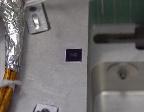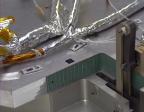What is the purpose of sending
names into space?
Placing the names onto the STARDUST spacecraft
was a public outreach effort. It allowed people
to be personally involved with the STARDUST Mission
and helps to promote public interest, awareness
and support of the space program. It also provided
a way to honor individuals by enabling them to
be associated with mankind's most advanced technological
endeavor and to be part of the quest of the human
species to reach for the stars.
Where are the microchips now?
The microchips are in outer
space onboard the STARDUST spacecraft, and also back on Earth.
STARDUST was launched
on February 7, 1999 carrying the two
sets of microchips. Two copies of each chip were
installed on the spacecraft (for a total of four
chips). One set of microchips is mounted inside
the Sample Return Capsule, and was returned back
to Earth with the capsule when it landed in Utah on January 15, 2006. The capsule along with the microchips have been transported to the curation facility at Johnson Space Center in Houston, Texas on January 17, 2006, where they currently reside.
The
other set of chips is mounted in the spacecraft
body and will remain in space forever.
Where are the microchips inside the Sample Return Capsule?
Refer to the photos below, which were taken prior to Stardust's launch.



How were the names collected?
During the first name collection period in October-November
1997, the names were submitted to the Planetary
Society who collected the names for us. The names
were submitted by email, postcard or the Planetary
Society home page. During the second name collection
period, which ran from May 1998 to August 1998,
the names were submitted via the Web on the STARDUST
home page and the National Space Society home
page.
How many names are on the microchips?
There are two microchips. The first one has 136,000
names and the second has over 1 million names.
Can I still put my name on
a microchip?
Sorry, no. The final deadline for submitting names
was August 15, 1998. Following that date the names
were engraved on the microchips and mounted in
the STARDUST spacecraft. The spacecraft was launched
February 7th, 1999 and is on its way to a rendezvous
with comet Wild 2 in January 2004.
Whose names are on the microchips?
The names on the microchips are from individuals
who submitted their own names along with the names
of friends and family if they chose to include
them. Also, all members of the Planetary Society
and the National Space Society current as of 1998
were included. In addition, as a special tribute,
all
names on the Vietnam War Memorial in
Washington, DC were included. And finally, the
names and selected photos of members of the STARDUST
Mission team were also included.
Will the microchips remain
in space or will they come back to Earth?
Both. Two copies of each microchip were made.
One set will remain in space in the STARDUST spacecraft
which will continue to orbit the Sun after the
mission. The other set of chips will be returned
to Earth in the Sample Return Capsule. Plans are
to place the returned microchips in a major museum, most likely the Smithsonian Air & Space Museum in Washington, D.C.
How can I contact a person whose name is on one
of the microchips?
Contact information is not available for any persons
listed on the microchips through the STARDUST
office. We did not collect any email addresses
or other contact information for the individuals
listed on the chips.
I am doing genealogy research.
How can I find out more about a name listed on
a microchip?
We've been overwhelmed with email from people
who have been researching their family tree, and
encountered names from their family on our microchip
name listings on our website. Unfortunately, since
we did not collect any additional information
other than their name, we do do not have any background
information on any of the people whose names were
submitted, nor do we have any way of contacting
these people.
Do you have the email addresses of persons whose
submitted names for the microchip?
No, this information was not collected from the
persons who submitted the names.
How big are the microchips?
The names are electronically etched onto a fingernail-size
silicon chip at JPL's Micro Devices Lab. Writing
on the microchip is so small that about 80 letters
would equal the width of a human hair. Once inscribed,
the names can be read with a strong optical microscope
or an electron microscope.
Can you provide more details on how the names
were engraved onto the microchips?
Sure. The process is rather technical, but we'll
give it a try. First, note that the microchip
is not an a electronic part like a computer chip,
but is actually a silicon wafer. The names are
placed onto the wafer chip through a technique
called Electron Beam Lithography. The wafer is
4 inches square initially and comes with a layer
of silicon oxide on its surface.. The wafer is
coated with a thin photographic film of photo-resist
PMMA (pexiglass). The names are stored on a VAX
computer and converted into a format usable by
the electron beam lithography tool. The data is
read and fed into the electron beam tool which
engraves the names into the PMMA surface of the
wafer chip using a highly-focused electron beam.
The names can be written multiple times to the
wafer if we want to make multiple copies of the
small microchip. The wafer then goes through a
process similar to developing film, where the
wafer is rinsed in a developer that removesexposed
PMMA (or the area written on by the electron beam).
The next step is to coat the wafer with a thin
metal film (titanium & platinum). This is
done by placing it in a vacuum chamber and heating
a small amount of the metal, which evaporates
and coats the wafer by condensing on it. The wafer
chip is then placed in a solvent which dissolves
away the remaining PPMA and any metal attached
to it, leaving behind the letters of the names.
Finally, the wafer is cut up into 1x1 centimeter-sized
square chips.
-- Ron Baalke

| Last updated February 2, 2010 |
|
